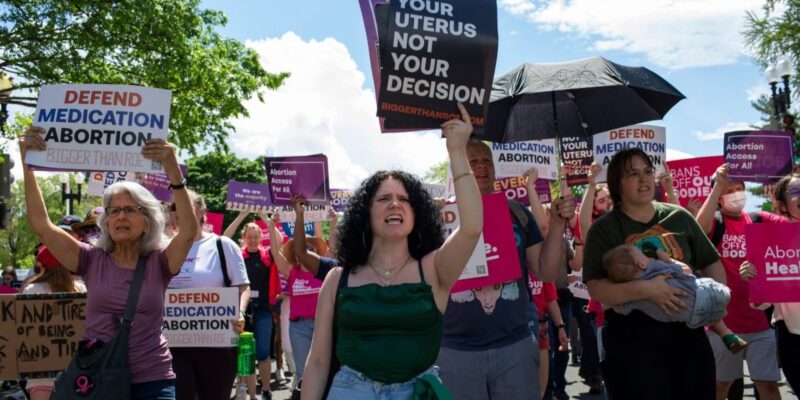
More Americans are stockpiling abortion pills in case they need them in the future, according to new research published Tuesday.
The relatively new practice of requesting a prescription for abortion pills before potentially needing them—known as advance provision—has spiked during two periods of recent uncertainty about the future of abortion access, the study published in JAMA Internal Medicine found. Those periods included two critical moments: the weeks following the May 2, 2022 leak of the Supreme Court’s draft decision in Dobbs v. Jackson Women’s Health Organization and amid conflicting rulings last April about the FDA’s approval of mifepristone, the first pill in the two-pill regimen that comprises medication abortion.
Studying data from the nonprofit organization Aid Access, whose doctors prescribe and mail abortion pills to people in all 50 states, researchers found that the average number of daily requests for advance provision increased nearly tenfold—to about 247 a day—in the seven weeks between the leak of the Dobbs draft and when the Supreme Court issued its final decision. Once the Supreme Court issued its final ruling in June 2022, requests decreased to about 89 per day—but then they spiked again last April when conflicting rulings about the FDA approval of mifepristone thrust abortion pills back into the headlines, leading to an average of about 172 daily requests for advance provision of the pills. (While a lawsuit challenging the FDA approval brought by anti-abortion activists is currently pending before the Supreme Court, abortion pills remain available by mail.)
“I think it shows people are paying attention” to threats to access, Abigail Aiken, the study’s lead author and associate professor of public affairs at the University of Texas-Austin, said, emphasizing that nearly three-quarters of participants cited wanting “to ensure personal health and choice” and “to prepare for possible abortion restrictions” as their reasons for requesting advance provision.
“I think one of the perhaps unintended consequences of abortion bans, or of the Dobbs decision, is that it really does shine a light on medication abortion, and probably made it more visible to a lot of people out there,” she added.
But inequities in access to advance provision of abortion pills remain. Most people who requested the pills were white people over 30 who didn’t have kids and lived in urban areas with lower-than-average poverty rates; most people who obtain abortions, on the other hand, are women of color, in their 20s, and already have children, data has shown, and nearly half live below the federal poverty line. The discrepancy in the demographics of people who get abortions and those who manage to get advance provision of abortion pills is likely due, in part, to cost: Aid Access charges $150 for advance provision. The group offers funding for people who may not be able to afford the pills, but that assistance may not be as widely known.
As Elisa Wells, co-founder of Plan C, a website that provides information about accessing abortion pills, told Mother Jones, “Not everybody has $150 to spend on something they may never need.” (Wells was not involved with Aiken’s study.)
For Americans who can get pregnant, Wells and her colleagues at Plan C see stocking up on abortion pills as a “reasonable thing to do.” The pills should have a shelf life of several years if stored properly (in their original packaging, and at room temperature): mifepristone, which blocks the pregnancy hormone progesterone, lasts about five years, and misoprostol, which causes the cervix to contract, expelling the pregnancy, lasts around two years, according to Plan C.
Medication abortion already accounts for more than half of all abortions nationwide, according to the Guttmacher Institute—and Aiken’s study suggests advance provision could continue to increase as abortion restrictions mount. The highest number of requests for advance provision of the pills, she said, came not from people in states with current abortion bans, but those in states where legislators were considering future bans.
“Every time we’re seeing uncertainty, every time we’re seeing potential legislation coming, that’s when people seem to be reacting most,” Aiken said. “They see the writing on the wall—and that seems to be the biggest motivator.”















